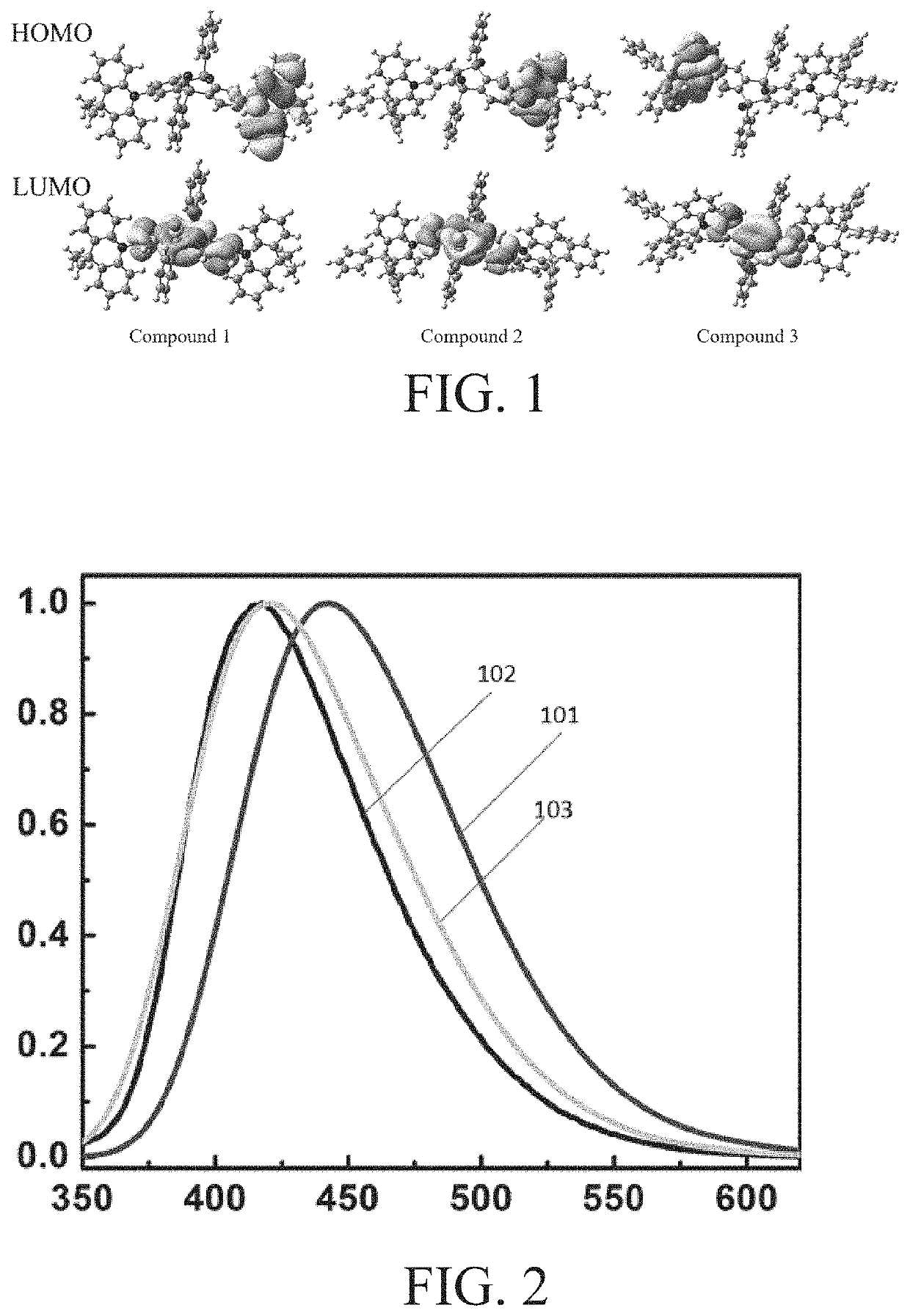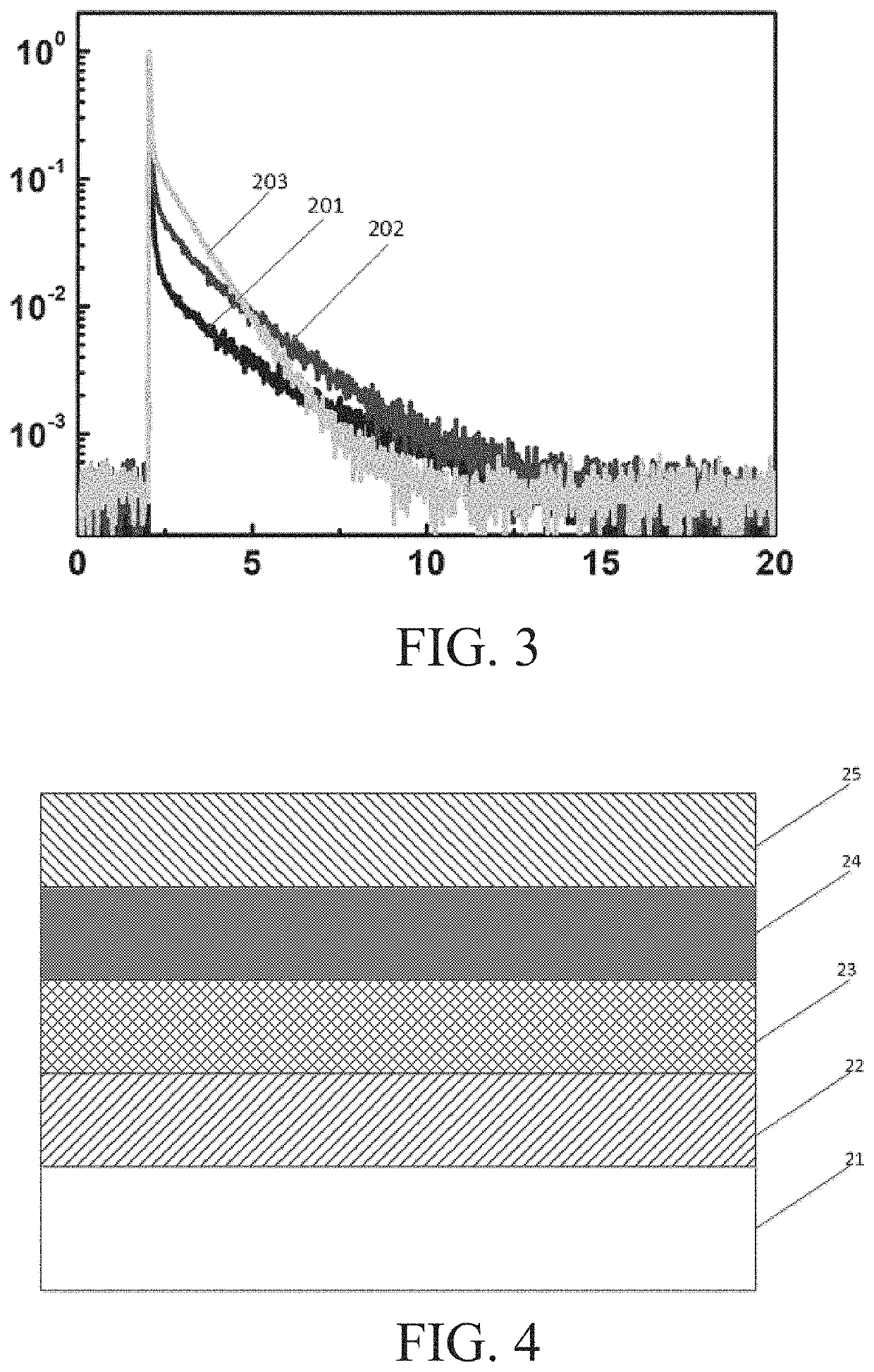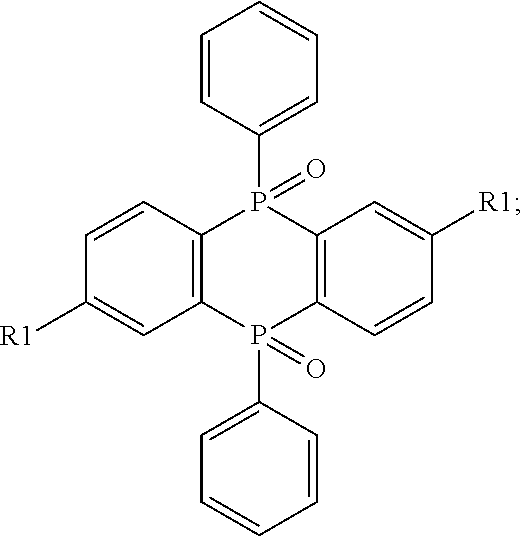Method for preparing sensitizing material and organic light emitting diode
a light-emitting diode and sensitizing material technology, applied in the field of display technologies, can solve the problems of limiting the application of fluorescent electroluminescent devices and the only 25% of sensitizing materials based on fluorescent materials, and achieve the effect of widening the color gamut, improving internal quantum efficiency and lifespan of organic light-emitting diodes
- Summary
- Abstract
- Description
- Claims
- Application Information
AI Technical Summary
Benefits of technology
Problems solved by technology
Method used
Image
Examples
embodiment 1
[0047]2.80 g and a molar amount of 5 mmol of the intermediate, 1.14 g and a molar amount of 6 mmol of 9,10-dihydro-9,9-dimethylacridine, 45 mg and a molar amount of 0.2 mmol of palladium acetate (Pd(OAc)2) and 0.17 g and a molar amount of 0 6 mmol of tri-tert-butylphosphine tetrafluoroborate are separately added into a two-neck flask having a capacity of 100 ml and mixed. After that, the two-neck flask is placed in a glove box, working gas of the glove box is argon. 0.58 g and a molar amount of 6 mmol of sodium tert-butoxide (NaOt-Bu) is added in advance to the glove box, and 40 ml of toluene dehydrated and deaerated is injected, the mixed solution in the above-mentioned two-neck flask and sodium tert-butoxide and toluene in the glove box are reacted therewith at a temperature of 120° C. for 48 hours to obtain a second reaction solution. The second reaction solution is cooled to room temperature, and then the second reaction solution is poured into 50 ml of ice water, and extracted ...
embodiment 2
[0052]2.80 g and a molar amount of 5 mmol of intermediate, 2 g and a molar amount of 6 mmol of 9,10-dihydro-9,9-diphenylacridine, 45 mg and a molar amount of 0.2 mmol of palladium acetate (Pd(OAc)2), and 0.17 g and a molar amount of 0.6 mmol of tri-tert-butylphosphine tetrafluoroborate ((t-Bu)3HPBF4) are separately added into a two-neck flask having a capacity of 100 ml and mixed. After that, the two-neck flask is placed in a glove box, working gas of the glove box is argon. 0.58 g and a molar amount of 6 mmol of sodium tert-butoxide (NaOt-Bu) is added in advance to the glove box, and 40 ml of toluene dehydrated and deaerated is injected, the mixed solution in the above-mentioned two-neck flask and sodium tert-butoxide and toluene in the glove box are reacted therewith at a temperature of 110° C. for 24 hours to obtain a second reaction solution. The second reaction solution is cooled to room temperature, and then the second reaction solution is poured into 200 ml of ice water, and ...
embodiment 3
[0056]2.80 g and a molar amount of 5 mmol of intermediate, 2 g and a molar amount of 6 mmol of 9,10-dihydro-9,9-diphenylsilylacridine, 45 mg and a molar amount of 0.2 mmol of palladium acetate (Pd(OAc)2), and 0.17 g and a molar amount of 0.6 mmol of tri-tert-butylphosphine tetrafluoroborate ((t-Bu)3HPBF4) are separately added into a two-neck flask having a capacity of 100 ml and mixed. After that, the two-neck flask is placed in a glove box, working gas of the glove box is argon. 0.58 g and a molar amount of 6 mmol of sodium tert-butoxide (NaOt-Bu) is added in advance to the glove box, and 40 ml of toluene dehydrated and deaerated is injected, the mixed solution in the above-mentioned two-neck flask and sodium tert-butoxide and toluene in the glove box are reacted therewith at a temperature of 110° C. for 24 hours to obtain a second reaction solution. The second reaction solution is cooled to room temperature, and then the second reaction solution is poured into 200 ml of ice water,...
PUM
| Property | Measurement | Unit |
|---|---|---|
| weight | aaaaa | aaaaa |
| weight | aaaaa | aaaaa |
| weight | aaaaa | aaaaa |
Abstract
Description
Claims
Application Information
 Login to View More
Login to View More - R&D
- Intellectual Property
- Life Sciences
- Materials
- Tech Scout
- Unparalleled Data Quality
- Higher Quality Content
- 60% Fewer Hallucinations
Browse by: Latest US Patents, China's latest patents, Technical Efficacy Thesaurus, Application Domain, Technology Topic, Popular Technical Reports.
© 2025 PatSnap. All rights reserved.Legal|Privacy policy|Modern Slavery Act Transparency Statement|Sitemap|About US| Contact US: help@patsnap.com



